Last Updated on May 19, 2022 at 6:55 pm
Starting today, we will study the efficacy of a double moving average market timing model with different stock market indices. We have already established that the model reasonably works (see links below) across asset classes. Our primary goal in this updated study is to illustrate market-specific risks and the sequence of returns risk with market timing.
It will take a few articles for these risks to unfold so we request some patience from the reader. Please do not jump to conclusions on the suitability or unsuitability of the model until all results are in.
It must also be understood that market-specific risks and sequence of return risks are also applicable to systematic investing. The aim of this is to point out that no strategy (systematic or tactical) will work all the time and will work for all markets.
We have already established the above observation for systematic investing several times in the past. See: Do not expect returns from mutual fund SIPs! Do this instead! And Stock market always moves up in the long term but returns move up and down!
Join 32,000+ readers and get free money management solutions delivered to your inbox! Subscribe to get posts via email! (Link takes you to our email sign-up form)
🔥Want to create a complete financial plan? Learn goal-based investing? Exclusive access to our DIY tools? Increase your income with your skills? Enjoy massive discounts on our robo-advisory tool & courses! 🔥
Past work: We have already established that the double moving average method is reasonably effective from an analyst’s point of view.
- Gold (1) Is this a good time to buy gold? A tactical buying strategy for gold
- Equity (large cap) (2) This “buy high, sell low” market timing strategy surprisingly works!
- Equity (Small cap) (3) Do not use SIPs for Small Cap Mutual Funds: Try this instead!
- Gilts (4) Can we get better returns by timing entry & exit from gilt mutual funds?
- Gilts updates (5) Is it possible to time entry and exit from gilt mutual funds for better returns?
- We have also developed a tool based on this strategy: A tool for tactical buying and selling using moving averages
- For other tactical strategy backtests (eg. with PE), explore the Tactical Asset Allocation archives.
All our articles on the subject come with lengthy disclaimers about the risks of market timing. We now have an opportunity to showcase the risks with some hard data.
That said, we would also like to point out that the stance taken by the financial services community in general about market timing is wrong. If someone says “Mount Everest can never be claimed”, they are clearly lying. If someone says, “It is extremely hard to climb Mount Everest, then they are being pragmatic”.
The financial services industry has conveniently changed pragmatism (it is hard to time the markets) into a convenient lie (“the markets cannot be timed”).
Is it possible to the time the capital markets? The answer is a resounding “yes”.
Is it possible to find one timing method that will work all the time? The answer is a resounding “no”. Just like systematic investing will not be fruitful at all times, timing will not also provide a reward commensurate with risk at all times.
Can the typical retail investor pull off-market timing? Unlikely. Timing requires higher discipline than systematic investing (which is often nothing more than automation). Most investors fear taxes and avoid rebalancing. Tactical strategies require equity to debt switches or vice versa at least once a year!
At freefincal, we deal with facts. We do not moralise on right and wrong and fudge facts. If you are easily confused and believe less is more, then we recommend not reading this series.
They say “emotions cannot be backtested”. Fair enough. But then such people should not hail the merits of systematic investing for emotions wreak havoc there too!
Warning and disclaimer: Please recognise results shown in backtests do not factor in future market movements especially sharp price fluctuations and sequence of returns, human emotions, taxation and exit loads. All these would impact the outcome of market timing.
Tactical (double moving averages) vs Systematic Investing: Nasdaq 100 TRI (USD)
We shall use Nasdaq 100 TRI (USD) for the test from April 1999 to May 2022. The index need not be converted into INR since the USD-INR conversion is common to both strategies. For the debt part, we consider a fixed-income instrument offering 2.8% a year.
Systematic investing: A sum is invested each month in equity and debt. We shall consider 50% equity and 50% debt over 5 years, 10 years and 15 years. The portfolio is rebalanced annually. Taxes and exit loads due to this are not considered.
Tactical investing: If the six -months moving average (6MMA) of Nasdaq 100 is greater than the 12-month moving average (12MMA) then all debt holdings are sold and invested in equity. All future investments are also made in equity.
If 6MMA < 12 MMA, then all equity holdings are sold and invested in debt. All future investments are also made in debt. Tax and exit load due to the switches are not considered. However, typically the average number of switches is lesser than annual rebalancing. For example, the no of buy/sell switches over 5 years is only about twice on average; is about 4 on average over 10 years; and about 5 on average over 15 years.
This is an example of a single 15-year run.
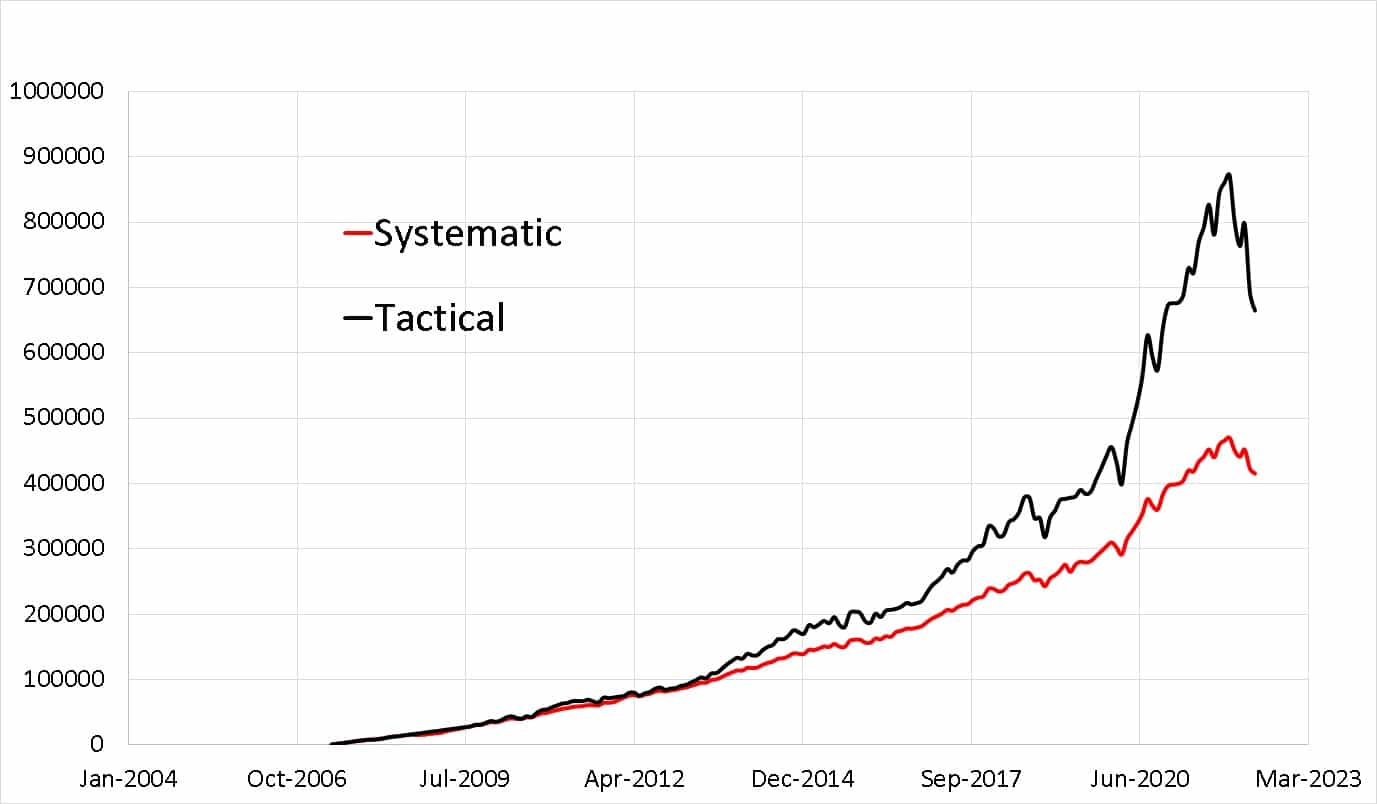
Between April 1999 to May 2022, 98 such 15-year windows are possible when rolled over monthly. The results for these are shown below.

Top left panel: the XIRR. For the period studied, the tactical strategy has done quite well.
Top right panel: The maximum drawdown (max fall from peak) of the portfolio is shown (less negative the better). The tactical strategy has a much higher drawdown. Higher risk.
Bottom left panel: The standard deviation or volatility (lower the better). The tactical approach has higher volatility.
Bottom right panel: the max no of months the portfolio was below its peak or underwater (lower the better). There is not much difference between the two strategies.
It must be understood that the results depend on the asset allocation chosen. For example, the above is 50% equity and 50% debt. If we change this to 70% equity and 30% equity then the results over 15 years look like this.
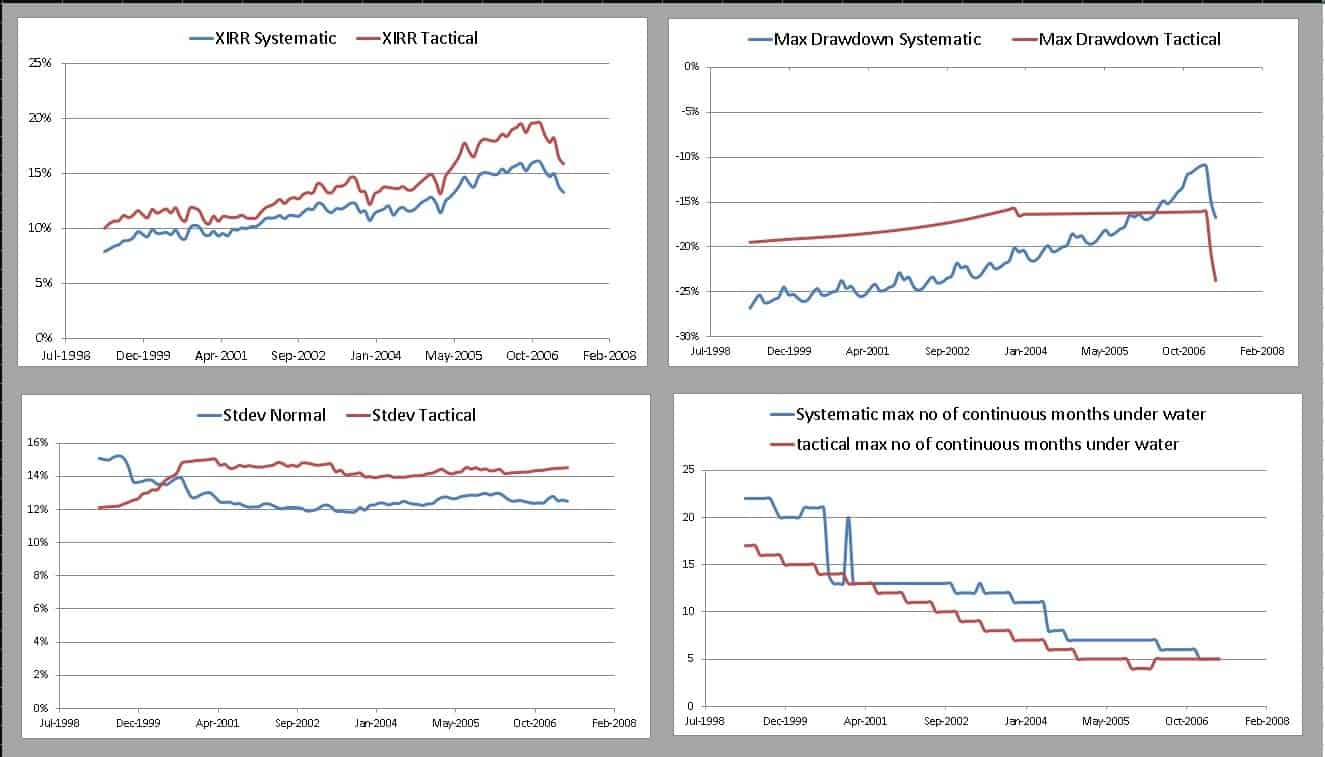
Notice that the margin of outperformance of the tactical strategy has significantly reduced. The higher risk associated with the tactical strategy has also decreased. This pattern is also observed over 10 and 5 years. This is a key feature that must be always kept in mind.
We shall present results below over 10 and 15 years and for both asset allocations.
50% Equity and 50% debt over 10 years
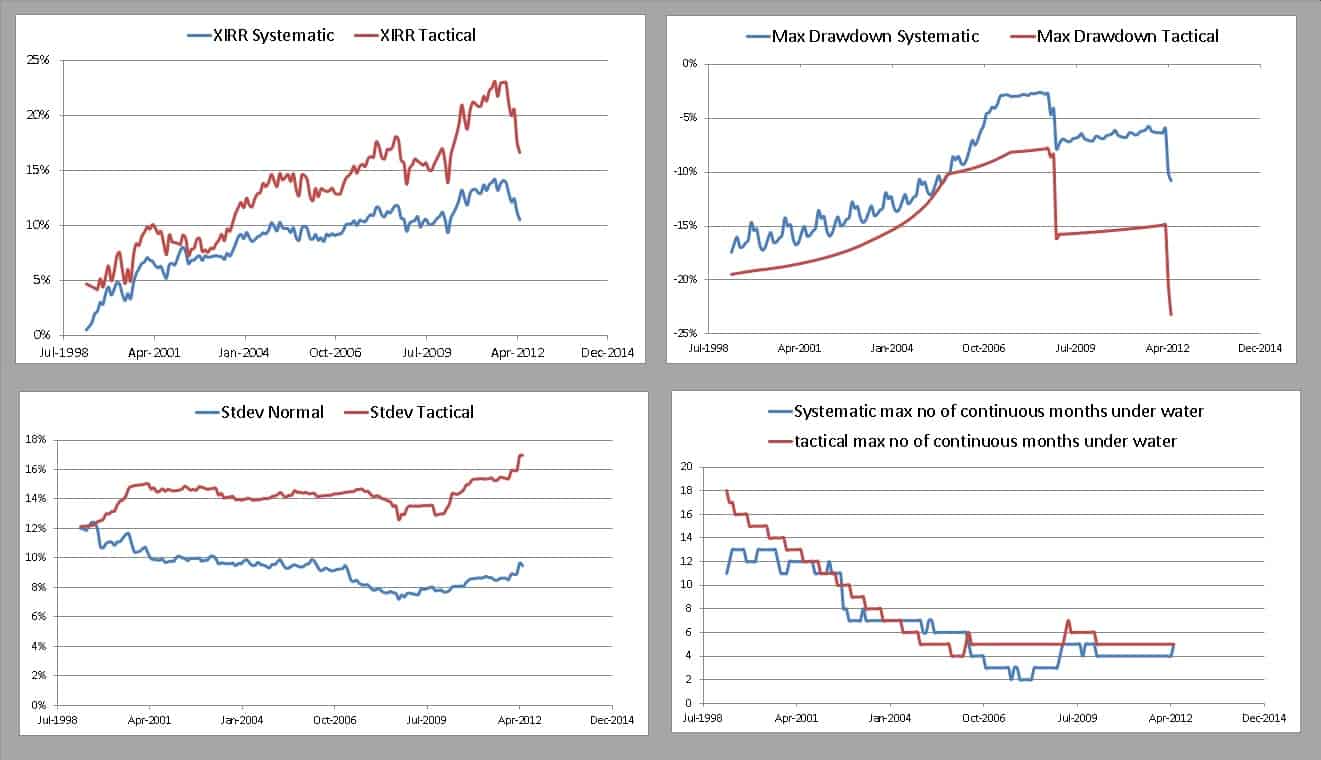
70% Equity and 30% debt over 10 years
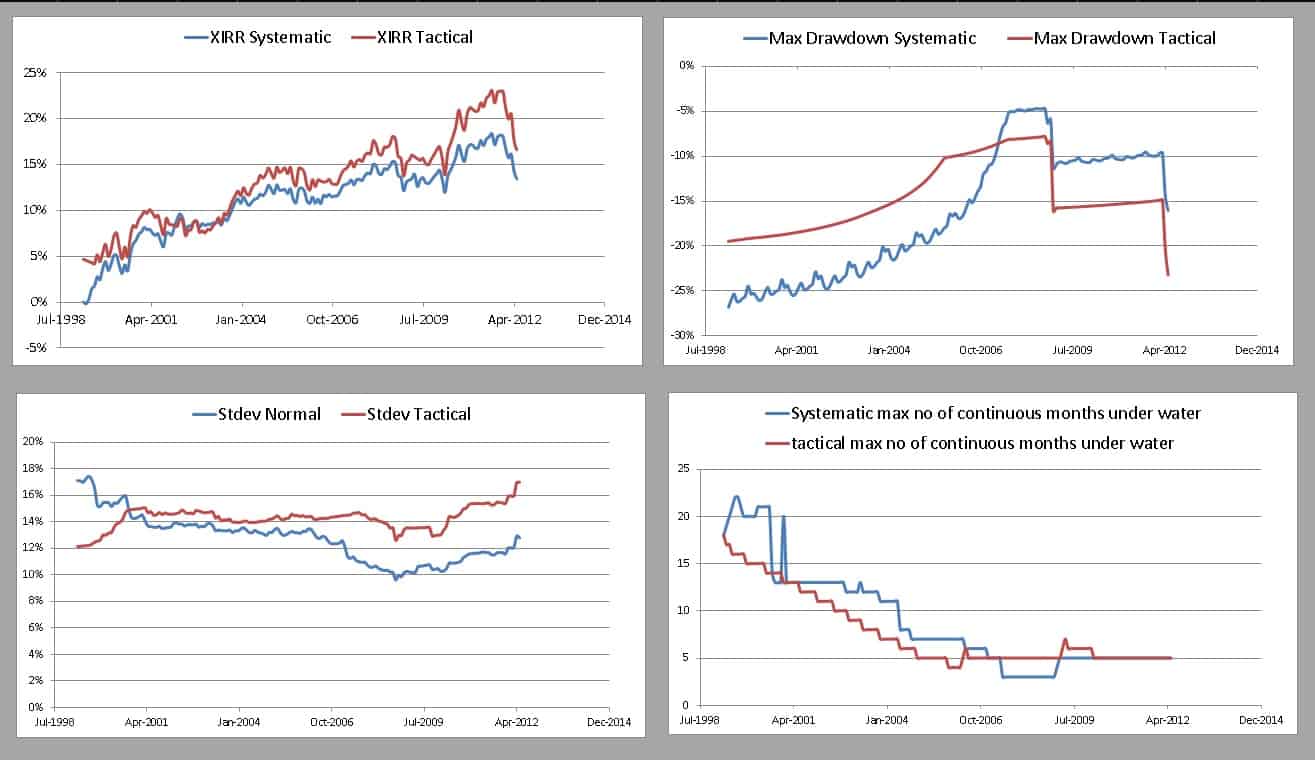
50% Equity and 50% debt over 5 years

70% Equity and 30% debt over 5 years
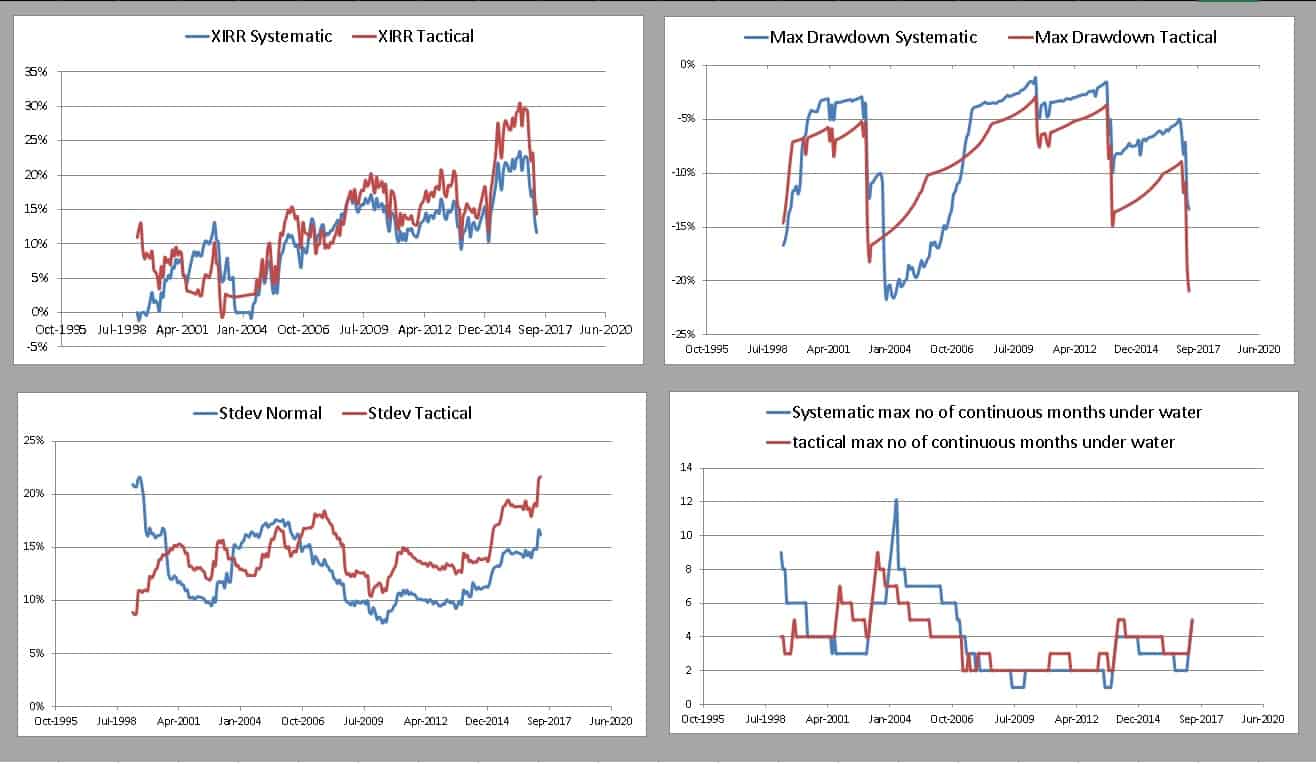
The above results indicate that the double moving average based tactical strategy has a higher risk than systematic investing. For Nasdaq 100, for the duration and asset allocations considered the strategy has, more often than not, offered a higher reward than systematic investing.
This does not however mean it will work in future or with other markets as we shall see over the next parts of the series. In part 2, we shall backtest this strategy from 1900 to 2022 using S&P 500 TRI (USD) data.
🔥Enjoy massive discounts on our courses, robo-advisory tool and exclusive investor circle! 🔥& join our community of 7000+ users!
Use our Robo-advisory Tool for a start-to-finish financial plan! ⇐ More than 2,500 investors and advisors use this!
Track your mutual funds and stock investments with this Google Sheet!
We also publish monthly equity mutual funds, debt and hybrid mutual funds, index funds and ETF screeners and momentum, low-volatility stock screeners.





- Do you have a comment about the above article? Reach out to us on Twitter: @freefincal or @pattufreefincal
- Have a question? Subscribe to our newsletter using the form below.
- Hit 'reply' to any email from us! We do not offer personalized investment advice. We can write a detailed article without mentioning your name if you have a generic question.
Join 32,000+ readers and get free money management solutions delivered to your inbox! Subscribe to get posts via email! (Link takes you to our email sign-up form)
About The Author
 Dr M. Pattabiraman(PhD) is the founder, managing editor and primary author of freefincal. He is an associate professor at the Indian Institute of Technology, Madras. He has over ten years of experience publishing news analysis, research and financial product development. Connect with him via Twitter(X), Linkedin, or YouTube. Pattabiraman has co-authored three print books: (1) You can be rich too with goal-based investing (CNBC TV18) for DIY investors. (2) Gamechanger for young earners. (3) Chinchu Gets a Superpower! for kids. He has also written seven other free e-books on various money management topics. He is a patron and co-founder of “Fee-only India,” an organisation promoting unbiased, commission-free investment advice.
Dr M. Pattabiraman(PhD) is the founder, managing editor and primary author of freefincal. He is an associate professor at the Indian Institute of Technology, Madras. He has over ten years of experience publishing news analysis, research and financial product development. Connect with him via Twitter(X), Linkedin, or YouTube. Pattabiraman has co-authored three print books: (1) You can be rich too with goal-based investing (CNBC TV18) for DIY investors. (2) Gamechanger for young earners. (3) Chinchu Gets a Superpower! for kids. He has also written seven other free e-books on various money management topics. He is a patron and co-founder of “Fee-only India,” an organisation promoting unbiased, commission-free investment advice.Our flagship course! Learn to manage your portfolio like a pro to achieve your goals regardless of market conditions! ⇐ More than 3,000 investors and advisors are part of our exclusive community! Get clarity on how to plan for your goals and achieve the necessary corpus no matter the market condition is!! Watch the first lecture for free! One-time payment! No recurring fees! Life-long access to videos! Reduce fear, uncertainty and doubt while investing! Learn how to plan for your goals before and after retirement with confidence.
Our new course! Increase your income by getting people to pay for your skills! ⇐ More than 700 salaried employees, entrepreneurs and financial advisors are part of our exclusive community! Learn how to get people to pay for your skills! Whether you are a professional or small business owner who wants more clients via online visibility or a salaried person wanting a side income or passive income, we will show you how to achieve this by showcasing your skills and building a community that trusts and pays you! (watch 1st lecture for free). One-time payment! No recurring fees! Life-long access to videos!
Our new book for kids: “Chinchu Gets a Superpower!” is now available!


Must-read book even for adults! This is something that every parent should teach their kids right from their young age. The importance of money management and decision making based on their wants and needs. Very nicely written in simple terms. - Arun.Buy the book: Chinchu gets a superpower for your child!
How to profit from content writing: Our new ebook is for those interested in getting side income via content writing. It is available at a 50% discount for Rs. 500 only!
Do you want to check if the market is overvalued or undervalued? Use our market valuation tool (it will work with any index!), or get the Tactical Buy/Sell timing tool!
We publish monthly mutual fund screeners and momentum, low-volatility stock screeners.
About freefincal & its content policy. Freefincal is a News Media Organization dedicated to providing original analysis, reports, reviews and insights on mutual funds, stocks, investing, retirement and personal finance developments. We do so without conflict of interest and bias. Follow us on Google News. Freefincal serves more than three million readers a year (5 million page views) with articles based only on factual information and detailed analysis by its authors. All statements made will be verified with credible and knowledgeable sources before publication. Freefincal does not publish paid articles, promotions, PR, satire or opinions without data. All opinions will be inferences backed by verifiable, reproducible evidence/data. Contact information: To get in touch, use this contact form. (Sponsored posts or paid collaborations will not be entertained.)
Connect with us on social media
- Twitter @freefincal
- Subscribe to our YouTube Videos
- Posts feed via Feedburner.
Our publications
You Can Be Rich Too with Goal-Based Investing
 Published by CNBC TV18, this book is meant to help you ask the right questions and seek the correct answers, and since it comes with nine online calculators, you can also create custom solutions for your lifestyle! Get it now.
Published by CNBC TV18, this book is meant to help you ask the right questions and seek the correct answers, and since it comes with nine online calculators, you can also create custom solutions for your lifestyle! Get it now.Gamechanger: Forget Startups, Join Corporate & Still Live the Rich Life You Want
 This book is meant for young earners to get their basics right from day one! It will also help you travel to exotic places at a low cost! Get it or gift it to a young earner.
This book is meant for young earners to get their basics right from day one! It will also help you travel to exotic places at a low cost! Get it or gift it to a young earner.Your Ultimate Guide to Travel
 This is an in-depth dive into vacation planning, finding cheap flights, budget accommodation, what to do when travelling, and how travelling slowly is better financially and psychologically, with links to the web pages and hand-holding at every step. Get the pdf for Rs 300 (instant download)
This is an in-depth dive into vacation planning, finding cheap flights, budget accommodation, what to do when travelling, and how travelling slowly is better financially and psychologically, with links to the web pages and hand-holding at every step. Get the pdf for Rs 300 (instant download)